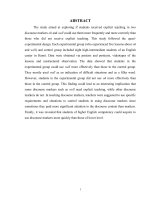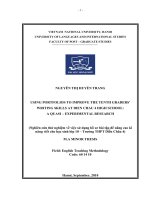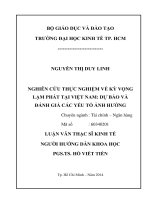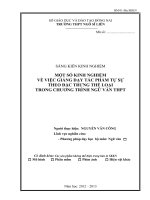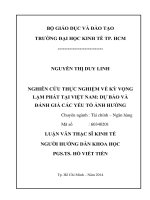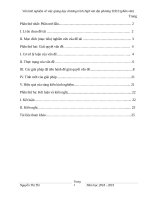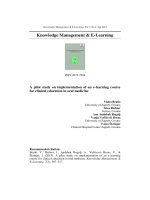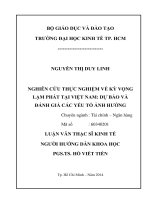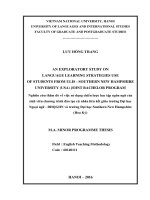NGHIÊN cứu bán NGHIỆM về VIỆC GIẢNG dạy 2 dấu HIệU DIễN NGÔN OH và WELL
Bạn đang xem bản rút gọn của tài liệu. Xem và tải ngay bản đầy đủ của tài liệu tại đây (341.52 KB, 92 trang )
ABSTRACT
The study aimed at exploring if students received explicit teaching in two
discourse markers oh and well could use them more frequently and more correctly than
those who did not receive explicit teaching. This study followed the quasi-
experimental design. Each experimental group (who experienced five lessons about oh
and well) and control group included eight high-intermediate students of an English
center in Hanoi. Data were obtained via pretests and posttests, videotapes of the
lessons and unstructured observation. The data showed that students in the
experimental group could use well more effectively than those in the control group.
They mostly used well as an indication of difficult situations and as a filler word.
However, students in the experimental group did not use oh more effectively than
those in the control group. This finding could lead to an interesting implication that
some discourse markers such as well need explicit teaching, while other discourse
markers do not. In teaching discourse markers, teachers were suggested to use specific
requirements and situations to control students in using discourse markers since
sometimes they paid more significant attention to the discourse content than markers.
Finally, it was revealed that students of higher English competency could acquire to
use discourse markers more quickly than those of lower level.
i
LIST OF TABLES
Table 1. Frequency of oh in the pretest for experimental group 13
Table 2. Frequency of oh in the pretest for control group 16
Table 3: Frequency of oh in the pretest and posttest for experimental
group
18
Table 4: Frequency of oh in the pretest and posttest for control group 19
Table 5: Frequency of well in the pretest for experimental group 20
Table 6: Frequency of well in the pretest for control group 22
Table 7. Frequency of well in the pretest and posttest for experimental
group
23
Table 8. Frequency of well in the pretest and posttest for control group 25
LIST OF ABBREVIATIONS
ii
TOEFL iBT Test of English as a Foreign Language – Internet-based Test
PPP Presentation – Practice - Production
TABLE OF CONTENTS
Acknowledgement……………………………………………………………. i
Abstract……………………………………………………………………… ii
iii
List of tables………………………………………………………………… iii
List of abbreviations………………………………….………………………. iv
CHAPTER 1: INTRODUCTION
1. Rationale…………………………………………………………………… 1
2. Aims and scope of the study……………………………………………… 1
3. Research questions………………………………………………………… 2
4. Study method………………………………………………………………. 2
5. Design of the study………………………………………………………… 2
CHAPTER 2: LITERATURE REVIEW
1. Definition of discourse markers…………………………………………… 3
2. The list of discourse markers………………………………………………. 3
3. Ways to recognize discourse markers…………………………………… 5
CHAPTER 3: METHODOLOGY
1. Research design……………………………………………………………. 8
2. Participants………………………………………………………………… 8
3. Data collection instruments……………………………………………… 9
3.1. Pretest and posttest………………………………………………………. 9
3.2. Videotapes……………………………………………………………… 9
3.3. Observation………………………………………………………………. 10
4. Data collection procedure………………………………………………… 10
5. Data analysis method………………………………………………………. 12
CHAPTER 4: RESULTS AND DISCUSSION
1. Results……………………………………………………………………… 13
1.1. The use of oh…………………………………………………………… 13
1.1.1. Performance in the pretest……………………………… ……………. 13
1.1.1.1. Experimental group………………………………………………… 13
1.1.1.2. Control group…………….………………………………………… 15
1.1.2. Performance in the posttest…………………………………………… 17
1.1.2.1. Experimental group…… …………………………………………… 17
1.1.2.2. Control group…………… ………………………………………… 19
1.2. The use of well…………………………………………………………… 18
1.2.1. Performance in the pretest… …………………………………………. 20
1.2.1.1. Experimental group…… …………………………………………… 20
1.2.1.2. Control group…………….………………………………………… 22
1.2.2. Performance in the posttest…………………………………………… 22
1.2.2.1. Experimental group………………………………………………… 22
1.2.2.2. Control group…………… ………………………………………… 24
2. Discussion…………………………………………………………………. 25
3. The implication in teaching discourse markers……………………………. 26
CHAPTER 5: CONCLUSION
1. Summary………………………………………………………………… 27
2. Research limitations……………………………………………………… 27
iv
3. Suggestion for further research……………………………………………. 28
REFERENCES……………………………………………………………… 29
APPENDICES………………………………………………………………… 31
v
CHAPTER 1: INTRODUCTION
1. Rationale
Discourse markers are not a new term. Over the decade, discourse markers have
caught much attention of many linguists, mostly in pragmatics field. However, not
many linguists research on teaching discourse markers explicitly. In Hanoi University
of Languages and International Studies, discourse markers have been studied in only
one paper and also from the perspective of pragmatics named “Discourse markers in
the dialogues of the Vietnamese new sets of English textbooks for lower secondary
school students – in the light of pragmatics.” Thus, “The quasi-experimental study on
teaching discourse markers oh and well” will serve as one of the leading studies on the
aspect of teaching discourse markers.
Moreover, discourse markers play an important role in communication. They
assist the conversationalists in understanding each other (Hirschberg and Litman,
1993, cited in Allen and Heeman, 1999; Marcus, 2009; Han, Dong and Xue, 2010),
which is helpful for the targeted researched students. They will go to America to study
as undergraduates, so learning to use discourse markers can somehow help ease their
communication difficulty with native speakers. It is worth mentioning that discourse
markers constitute spoken English, which will be used considerably in their daily
informal conversations. Using discourse markers successfully can partly smooth their
participation in communication; hence, somehow assist them to integrate quickly into
the new environment.
2. Aims and scope of the study
This study focuses on eight selected students in an English center, who will go
to America to study as undergraduates in August 2012. They joined a five-week
speaking course in which oh and well were taught. They were then compared with
other eight students of the same level, who experienced no lesson about oh and well.
Moreover, this study only focused on two discourse markers oh and well. These two
1
discourse markers were chosen because they are two of the most frequently used
discourse markers in the Inside Out Intermediate, the core material of the course.
3. Research questions
Above all, this study aims at answering two questions.
3.1. For students experiencing explicit teaching about discourse markers oh
and well, how more frequently and more correctly can they use oh and well in
comparison with those who don’t receive explicit teaching?
3.2. What are the implications in teaching discourse markers?
4. Study method
The researcher first referenced books, journals and online materials to build up
the literature review. Based on the literature review, the pretest and posttest were
designed. Also based on the literature review along with other references, the
researcher framed the syllabus of teaching two discourse markers oh and well.
The pretest was conducted first. The syllabus was then implemented and
experienced some changes in terms of content and activity after each lesson. After all
the lessons were instructed, the posttest was carried out and data were processed to
withdraw the research results.
5. Design of the study
The study includes five chapters. Chapter 1, introduction, consists of rationale,
aims and scope of the study, research questions, study method and design of the study.
Chapter 2, literature review, discusses definition of discourse markers, the list of
discourse markers and ways to recognize discourse markers. Chapter 3 mentions
methodology in which research design, participants, data collection instruments, data
collection procedure and data analysis method are incorporated. Chapter 4, results and
discussion, answers the two research questions including the comparison of the use of
oh and well between experimental and control groups and implication for teaching
discourse markers. Chapter 5, conclusion, covers summary, research limitations and
suggestion for further research.
2
CHAPTER 2: LITERATURE REVIEW
1. Definition of discourse markers
According to Andersen (2001), discourse markers are “a class of short,
recurrent linguistic items that generally have little lexical import but serve significant
pragmatic functions in conversations.” (cited in Zufferey and Belis, 2004, p. 2).
Discourse markers include words such as actually, and, but, I mean, like, so, you
know, and well. Sharing the same idea, Bolden (2006) defines discourse markers as “a
class of linguistic devices that includes words and expressions like anyway, but,
y’know and like among many others”
Hirschberg and Litman (1993) consider discourse markers the means to make
the hearer understand the discourse structure and the relation between newly presented
information with the old one as well as explain the anaphora (cited in Allen and
Heeman, 1999). From this definition, it is understood that discourse markers create the
connection within the discourse. Sharing the same idea, Martinez (2009) says: “They
are a set of clues which create cohesiveness, coherence and meaning in discourse”
(p.21). Redeker (1991) also mentions the linking function of discourse markers, which
are “ ‘a word or phrase, a conjunction, adverbial, comment clause, interjection – that is
uttered with the primary function of bringing to the listener’s attention a particular
kind of linkage of the upcoming utterance with the immediate discourse context.”
(cited in Han, Dong and Xue, 2010, p. 2). Han, Dong and Xue (2010) also include the
well-known definition of Deborah Schiffrin, who wrote “Discourse markers” in 1987.
Schiffirin (1987) regards discourse markers as “linguistic, paralinguistic or non-verbal
elements that signal relations between units of talk by virtue of their syntactic and
semantic properties and by virtue of their sequential relations as initial or terminal
brackets demarcating discourse units” (p. 40)
2. The list of discourse markers
It is not easy to classify discourse markers. For example, the discourse marker
list of Fraser (1990) is different from that of Schiffrin (1987). The former has 32 words
3
including consequently, also, above all, again, anyway, alright, alternatively, besides,
conversely, in other words, in any event, meanwhile, more precisely, nevertheless,
next, otherwise, similarly, or, and, equally, finally, in that case, in the meantime,
incidentally, OK, listen, look, on the one hand, that said, to conclude, to return to my
point, while I have you. The latter has only 23 words such as oh, well, but, and, or, so,
because, now, then, I mean, y’know, see, look, listen, here, there, why, gosh, boy, this
is the point, what I mean is, anyway, whatever. However, more words in the latter list
are shared by other researchers for example Brown and Yule (1983) and Engkent
(1986). Due to the complexity in classifying, the researcher thinks each word needs to
be individually investigated to decide if it is a discourse marker.
Two discourse markers studied in this paper are oh and well for three reasons.
First, the researcher relied on the literature that had been reviewed. Schiffrin (1987)
thinks both words are discourse markers. Sharing the same idea, Bolden (2006)
considers oh a discourse marker and well is regarded as a discourse marker by Marcus
(2009) and Han and Xue (2010). Second, oh and well are two discourse markers that
are used frequently in the Inside Out Intermediate, the material used to teach the
targeted students. It includes 15 lessons of various topics and each lesson aims to
improve students’ speaking, writing, reading, listening, grammar, lexis and
pronunciation. Much of the lexis, listening and speaking sections are utilized by the
researcher in teaching oh and well to the targeted students. Oh and well are two of the
most common discourse markers in the model conversations in the Inside Out
Intermediate. In this book, the conversation transcripts of lesson number 1, 5, 10 and
15 are analyzed. The transcript includes the use of 14 discourse markers (oh, but, and,
well, because, gosh, so, or, there, now, here, look, whatever, I mean) among which
and, but, well and oh are used the most frequently (62, 21, 15 and 14 times
respectively). Since and and but are more prevalent and their meanings are clearer than
oh and well, the researcher wanted to focus on oh and well in the hope of contributing
a new study to the language teaching and researching fields. Finally, since the
4
researcher needed to teach and post-test the students to get the data for this research
paper, she could not have enough time to teach more than two discourse markers.
3. Ways to recognize discourse markers
“Discourse markers are very ambiguous items” (Belis and Zufferey, 2004) and
one discourse marker can carry different functions. For example, the discourse marker
well can be an adverb (e.g. I know you well.) Thus, it’s important to disambiguate
discourse markers.
Belis and Zufferey (2004) also propose three ways to disambiguate discourse
markers. First, discourse markers tend to be attached with other words to create
collocations. For example, well can be integrated into well you know, well I think;
anyway can be in well anyway and oh can make up oh well, oh I see, oh really?
Second, discourse markers tend to stand at certain positions in an utterance. For
instance, well usually begin an utterance or a “prosodic unit” (Belis and Zufferey,
2004). Oh also serves to “preface utterances.” (Bolden, 2006)
Third, discourse markers usually carry prosody. Schiffrin (1987, p.328)
believes that “ ‘[a discourse particle] has to have a range of prosodic contours e.g.
tonic stress and followed by a pause, phonological reduction.” (cited in Belis and
Zufferey, 2004). Well and oh tend to be stressed and after these words, there is usually
a pause.
Moreover, it is necessary to understand the use of these two discourse markers.
According to Han and Xue (2010), well can be used in four ways. First, it is used in
case that information is not adequate. This idea is shared by Marcus (2009), who also
names this function of well as a “qualifier” and adds that well is used to “draw an
inaccurate assumption from the questioner,” or when the interlocutors “have difficulty
with the situation.” This is an example.
A: But otherwise, you lived in West Philly. Whereabouts?
5
B: Well, I was born at Fifty second and em…tks…oh I forgo-well…I think it’s
Fifty second and Chew.
B seems to have inadequate information to answer A and seems to have trouble
answering the question, so B uses well to show that.
Second, well is used to alleviate face-threatening acts including “disagreement,
challenge, rejection and criticism.” (Marcus, 2009) For example:
A: Can I just see them?
B: Um well I’m not allowed to do that.
In this case, well is used to lessen the seriousness of the refusal.
Third, well is used to show the shift in the conversation topic. For example:
A: Oh I suppose we shall be there about three or four months while we’re
getting the house, but it’s one of my mother’s apartment, so it doesn’t really worry me.
B: Very nice – well what did you do in San Francisco for eight days…
In this conversation, well is used so B can move on to another topic.
Finally, well is used as a “delay device” (Marcus, 2009). For example:
On the ….on the …well …on this … you know on the hatchway there.
The speaker uses well so she has more time to think about what should be said
next. In this case, well acts as a filler word.
In terms of oh, it is used to signify a “change of state”, “indexing a change in
the speaker’s knowledge, awareness, or attention in response to some prior action”
6
(Heritage, 1984a, 1998, 2002; James, 1972, 1974; Jefferson, 1978, Schiffrin, 1987,
cited in Bolden, 2006). For example:
W: Jack! It’s good to see you again. What have you been up to lately?
M: Not too much. I’m kind of worried about my housing situation, though.
W: Oh? How come?
In this conversation, the woman uses oh to express that she has just got the new
information that the man is worried about the housing situation. the woman has never
heard about this before.
7
CHAPTER 3: METHODOLOGY
1. Research design
This study followed the quasi-experimental design, which is defined as “to
expose two similar classes of students to alternative instructional strategies and
compare them on designated dependent measures (e.g., learning, attitude, classroom
behavior) during the year.” (Ross & Morrison, 1996, p. 1023). The quasi-experimental
design is illustrated in this study by the fact that two classes of the same English level
were chosen. They were then compared in terms of the correctness in using oh and
well after one class was exposed to the lessons of oh and well and the other was not.
The quasi-experimental design was helpful for the researcher to obtain data and
compare students in two classes.
2. Participants
Participants include 16 students of high-intermediate level in an English center.
All of them have passed the entrance test to high-intermediate TOEFL iBT classes
(Test of English as a Foreign Language – Internet-based Test). They were divided into
two classes, one of which includes eight students who will enroll into American
universities in August 2012. They formed the experimental group in which explicit
instructions on using oh and well were implemented. The other eight students formed
the control group in which no lesson about oh and well was taught.
The researcher selected these participants because of some reasons. First,
because discourse markers are a difficult linguistic item, students at high-intermediate
level can understand the use of oh and well and can use oh and well more quickly than
students at other levels. Second, some students will enroll in American universities
soon so if they manage to use oh and well – two rather popular discourse markers in
informal conversations, they will somehow encounter fewer difficulties in daily
communication with native speakers. They seem to be the type of students who benefit
the most from lessons of oh and well presented in this study.
3. Data collection instruments
8
For the triangulation, data were collected via pretests and posttests, videotapes
and observation.
3.1. Pretest and posttest
Before teaching the lessons, the researcher pretested students on their ability to
use oh and well. Two different tests of the same difficulty level were given to two
pairs (half of the class) in the pretest phase, then the two pretests were switched to
make the posttests (See Appendix 1). By this way, the researcher can avoid the
measurement issues in research presented by Brown (1988, p. 38), who claims that the
pretest and posttest should be congruent in terms of level of difficulty. Additionally,
one extra task in which students were asked to talk freely about their education plan
was integrated into the posttest. This task was added without any implicit request of
using oh and well to check if students could use oh and well unconsciously. (See
Appendix 1) The researcher interviewed students in pairs so she could easily instruct,
videotape and observe them in the pretest. After the researcher guided the students
through five lessons about oh and well, they were re-interviewed and videotaped in
pairs in the posttest session. After that, the videotapes were analyzed to detect if
students who received intensive training could use oh and well more often and more
correctly. It is noted that the researcher did not inform the students that they were
researched on their ability to use oh and well to avoid “Hawthorne effect,” (which
means the students may adapt their responses if knowing that they are researched) and
“subject expectancy” (which means the students can foresee the outcome of the
research and intentionally affect the outcome) (Brown, 1988).
3.2. Videotapes
The pretest and posttest sessions were videotaped so the researcher could obtain
sufficient data to detect if the students could use oh and well more often and more
correctly after joining five lessons. Several lessons were videotaped so the researcher
could give insight into if students could put the theory of oh and well into practice by
using oh and well in conversations.
9
3.3. Observation
Seliger and Shohamy (1989) believe observation is “a major data collection tool
in qualitative research.” (p. 162). Observation in this study was in the form of
unstructured observation (see Appendix 3), which was conducted by the researcher
while she was teaching. When teaching, the researcher observed and noted down the
problems or students’ behaviors and reactions that might help to explain the results of
the research.
4. Data collection procedure
Phase 1: Preparation
Based on the reviewed literature, the pretests, posttests and syllabus of five
lessons were designed. Each pretest and posttest (see Appendix 1) is comprised of five
situations in which students were required to converse in pairs. In each situation, the
students were also required to use oh and well in an implicit way, which would likely
help to inform the researcher if the students knew the specific usage of oh and well and
if they could use oh and well in conversations. The posttest included one additional
task asking about their future education plan to check if they could use oh and well
unconsciously.
In terms of syllabus, two syllabi were implemented. The first syllabus
including lessons about oh and well (see Appendix 2A and the attached CD) covered
five speaking lessons of five themes selected by the researcher namely friends,
relaxation, dating, party and style. These five themes were selected because the
researcher thought they would interest the students. The students learnt to speak about
the selected theme in the first 45 minutes of each lesson. In these first 45 minutes, each
lesson was conducted according to the PPP methodology (presentation, practice and
production), which means the researcher provided input about expressions and/or
discussion topics related to the theme, and then created various chances for students to
practice using the expressions and topics to talk in pairs or in groups. In the last 45
minutes, the researcher presented the use of oh and well then organized different
10
conversation situations for students to practice using oh and well. One use of oh and
four uses of well were presented to the students in five lesson. Five lessons of the same
themes were included in the second syllabus; nevertheless, no explicit teaching about
oh and well was integrated. These five lessons also followed PPP methodology. (See
Appendix 2B and the attached CD)
Phase 2: Pretest
In both experimental group (in which students were explicitly instructed about
oh and well) and control group, eight students were randomly divided into pairs and
each pair was asked to do the pretest in turns. Each pair was given instructions on how
to do the test by the researcher, who would be observing at the same time. The
researcher answered the students’ question if they had any and acted as a facilitator to
help the conversations go smoothly. The researcher asked another person to sit next to
her and videotape the pretest session.
Phase 3: Teach
In this phase, the researcher lectured five lessons of oh and well following the
pre-designed syllabus in the experimental group. The control group joined five lessons
of the same theme but did not experience any instruction about oh and well. Before
each lesson, the researcher went to class early to set up the necessary equipment such
as the laptop and the loudspeakers. The researcher then waited for all eight students to
come because it was essential that all students, especially those in the experimental
group, knew how the use of oh and well and had the chance to practice using oh and
well. This contributed to guarantee the accurate results of the research. Moreover, the
researcher took notes of students’ behaviors and acquisition of oh and well in each
lesson. After each lesson, the notes along with the videotapes were thoroughly
investigated to reveal how correctly students could use oh and well.
Phase 4: Posttest
Eight students of the same pairs as in the pretest joined the posttest. Each pair
made conversations about five themes similar to those in the pretest, which included
11
friends, relaxation, dating, party and style. Apart from taking about these themes, they
were required to talk about an additional topic about their future education plan. They
were videotaped as in the pretest and the videotapes of the pretest and posttest sessions
were analyzed to withdraw the results of the research.
5. Data analysis method
Quantitative and qualitative methods were used to analyze the data. Both
methods contribute to the understanding of data (Powell, 1996; Powell & Renner,
2003), thus they assisted the researcher significantly in withdrawing the research
results.
Quantitative method was also applied in counting the number of times students
could use oh and well in the pretest and compared that to the number of times in the
posttest session. This enabled the researcher to find out if students could use oh and
well more often after five weeks’ instructions.
Qualitative method was utilized to investigate if the students could use oh and
well correctly. In each experimental and control group, the students’ usage of oh and
well in each question was analyzed in light of the literature review and then were
compared with that in the posttest to detect if students progressed in using oh and well.
Moreover, the posttest performances of two groups were compared to realize any
difference in using oh and well. Qualitative method also helped the researcher to
analyze gestures of students in conversations.
12
CHAPTER 4: RESULTS AND DISCUSSION
1. Results
1.1. The use of oh
1.1.1. Performance in the pretest
1.1.1.1. Experimental group
Due to the fact that some data were lost, only data of four students in each
group could be analyzed. For the four students in the experimental group, all of them
managed to use oh.
Table 1. Frequency of oh in the pretest for experimental group
Student Frequency of oh Total
Topic 1 Topic 2 Topic 3 Topic 4 Topic 5
A1 2 4 1 2 0 9
B1 0 0 1 2 0 3
A2 8 2 1 7 3 21
B2 0 2 0 2 1 5
Mean = 9.5
(A1 and B1 formed a pair, A2 and B2 formed another pair)
In the experimental group, all students managed to use oh in the pretest, one of
them even used oh 21 times within five given tasks. Oh was accompanied with other
words to make collocations such as oh really or oh my God. For example:
A2: Ok how are you doing this weekend?
B2: Ah I’m going to watch movies.
A2: Oh really?
A2: Oh do you see that girl. She’s wearing some kind of slutty dress. [laughs]
B2: Oh my God! [laughs]
13
All four students used oh to express their surprise and this was relevant to the
use of oh – the word being uttered when new information is provided. It is concluded
from the literature review that oh is spoken to signify the new information; however, it
helps to reveal the emotional state of the speaker as well. In the two examples above,
oh expresses surprise. Oh can also be used to indicate negative feelings such as
annoyance. In the example below, A2 shows her dissatisfaction with the food in the
party.
A2: [laughs] I hate the kind of music they’re playing and they hire a very terrible DJ.
B2: Really?
A2:Yeah.
B2: Uhm
A2: And the food tastes bad. Oh it makes me want to throw up.
Moreover, oh has some variations in pronunciation. For instance, instead of
saying oh, one student used eh/ah/uh.
A1: Good afternoon! [laughs]
B1: Hi!
A1: [laughs] Oh ok. My name is Oanh. Nice to meet you.
B1: Ah ok! [A1: laughs] So your name is Oanh. Uh can you spell it?
A1: O-a-n-h.
B1: Uh ok! My name is Binh. [A1: Yeah.] B-i-n-h.
Another result is that oh is used to convey new information, yet the term
“information” varies. For example:
A2: Oh hi!
14
B2: Hi!
A2: Are you Thao? Long time no see then.
1
In this example, because A2 had just seen B2, an old high school classmate, A2
uttered oh hi with surprise. B2’s sudden appearance in front of A2 should be regarded
as new information here. In other words, the term “information” can be understood in
a broader sense such as event.
Although all four students in the experimental group used oh often, oh was used
incorrectly one time.
A1: Good afternoon! [laughs]
B1: Hi!
A1: [laughs] Oh ok. My name is Oanh. Nice to meet you.
In this case, B1 had not provided A1 with any new information; however, she
uttered oh ok, which didn’t seem proper.
1.1.1.2. Control group
A big gap existed between the use of oh among students in the experimental
group (mean = 9.5) and those in the control group (mean = 2.25).
Table 2. Frequency of oh in the pretest for control group
1
The symbol shows that both speakers speak at the same time. See Carter &
McCarthy (1997)
15
Student Frequency of oh Total
Topic 1 Topic 2 Topic 3 Topic 4 Topic 5
C1 0 0 0 0 0 0
D1 0 2 1 3 1 7
C2 0 0 0 0 0 0
D2 0 1 0 0 1 2
Mean = 2.25
(C1 and D1 formed a pair, C2 and D2 formed another pair.)
Different from students in the experimental group, those in the control group
did not use much oh; two students even did not use any oh at all. This could be
explained by the fact that one was shy of talking with a stranger; unfortunately, she
was paired with a classmate that she had never met before. For the other student, she
did not have the habit of using oh; she tended to use like, which happened a
considerable amount of times in her conversations.
Two other students used oh four times on average (mean = 4.5). They used oh
to show the surprise of receiving new information. For example:
D1: Have you ever seen the Chinese films?
C1: Yeah.
D1: Yeah? Eh so what’s your the most favorite film you like?
C1: Eh maybe Rush Hour.
D1: Rush Hour?
C1: Jackie Chan.
D1: Jackie Chan? Ok Crush Hour. Oh I haven’t seen this […]
In this piece of conversation, A used oh before “I haven’t seen this” so it could
be concluded that he used oh to signify new information.
16
Even though oh is used to signify new information, but again, the term
“information” needs to be understood in a broad sense. For example:
D2: Oh the music, I love this song.
So D2 was attending a party and a new song had just been played. He realized
that and said oh. In this situation, “ new information” here was the new song.
In general, students in both groups could use oh. Even though students in the
experimental group used more frequently, all students could use oh correctly in most
cases.
1.1.2. Performance in the posttest
1.1.2.1. Experimental group
After undergoing one lesson about oh, students in the experimental group
demonstrated some differences in the use of oh in the posttest session, which happened
five weeks after the pretest.
Table 3. Frequency of oh in the pretest and posttest for experimental group
Student Frequency of oh Total Frequency of oh Total
17
(pretest) (posttest)
T1 T2 T3 T4 T5 T1 T2 T3 T4 T5 Add.
task
A1 2 4 1 2 0 9 3 4 1 0 3 11 3
B1 0 0 1 2 0 3 2 1 1 1 0 5 2
A2 8 2 1 7 3 21 4 7 7 5 1 24 4
B2 0 2 0 2 1 5 0 1 1 0 0 2 2
Mean
= 9.5
Mean
= 10.5
From the table, it is clearly seen that three students used oh more in the posttest.
Furthermore, although student B1 did not use collocations of oh such as oh well and
oh I see in the pretest, he used them in the posttest after being explicitly taught about
it.
A1: I I I you know I get I got into a medical school [B: Oh.] yeah and and then I eh I
drop out because….
B1: What?
A1: Yeah because I think that you know eh medicine is is kinda boring.
B1: Oh well.
[…]
A1: […] And I think that you know eh work working in the lab eh in the you know a
modern lab is you know very interesting and I decide to eh study abroad.
B1: Oh I see.
Student A1 in the experimental group could use an interesting collocation that
had not been taught in the course, which was oh man.
A1: Hi!
B1: Hi!
18
A1: [laughs] Oh man, after 4 years and now you’re just you know be so indifferent
like this?
1.1.2.2. Control group
In regard to students in the control group, they improved slightly in the use of
oh.
Table 4. Frequency of oh in the pretest and posttest for control group
Student Frequency of oh
(pretest)
Total Frequency of oh
(posttest)
Total
T1 T2 T3 T4 T5 T1 T2 T3 T4 T5 Add. task
C1 0 0 0 0 0 0 2 0 2 1 1 6 2
D1 0 2 1 3 1 7 0 2 1 0 2 5 1
C2 0 0 0 0 0 0 1 1 1 0 0 3 1
D2 0 1 0 0 1 2 0 2 0 2 0 4 1
Mean
= 2.25
Mean
= 4.5
Student C1 experienced a significant increase in the use of oh (zero times in the
pretest and six times in the posttest). This likely resulted from the fact that she had
been familiar with other students so she felt comfortable expressing her emotions via
using oh. This finding tended to prove that the familiarity between the speakers could
better the flow of the conversation. The speaker’s personality can also affect the
communication. If the speaker is shy, she may find it hard to communicate with other
people. This interpretation was highlighted by the fact that another shy student in the
control class, student D2, who had only said oh two times in the pretest, said oh four
times in the posttest. He was also relaxed to say oh my God to express his surprise in
the posttest.
19
C2: I’m now eh I’m now unemployed and I’m now at home.
D2: Oh my God. I’m so sorry for that.
1.2. The use of well
1.2.1. Performance in the pretest
1.2.1.1. Experimental group
For four students in the experimental groups, two did not use any well, one used
well five times and one used well nine times.
Table 5. Frequency of well in the pretest for experimental group
Student Frequency of well Total
Topic 1 Topic 2 Topic 3 Topic 4 Topic 5
A1 0 0 0 0 0 0
B1 2 0 3 1 3 9
A2 1 3 1 1 0 5
B2 0 0 0 0 0 0
Mean = 3.5
For student B1, who used well most frequently among those in the experimental
group, he usually used well to describe difficult situations. The difficult situations
could belong to either him or his partner. For example:
B1: Ah well ah my first date is with a high school student so maybe she’s [A: Oh!]
childish or something.
A1: But it’s so sweet, right?
B1: Well, but ah ah ah maybe she’s too easy to angry and easy to smile and it’s hard to
[A1: inaudible] like satisfy her ah needs or something.
Another example is shown below.
20

